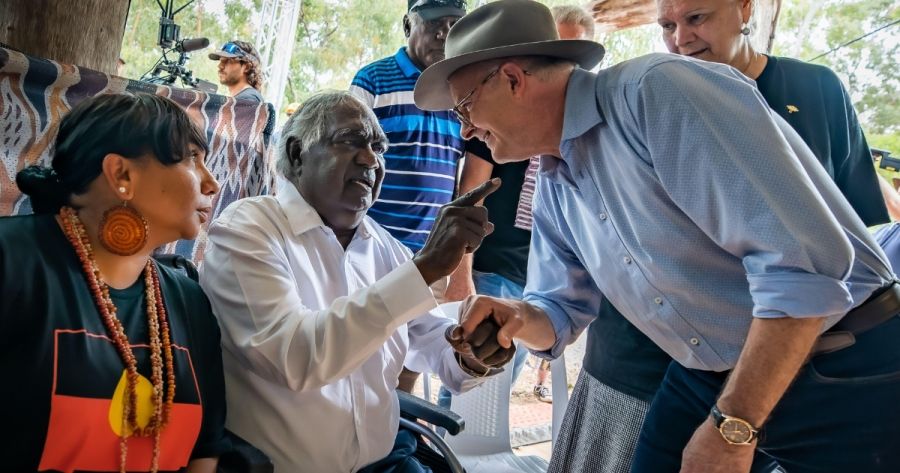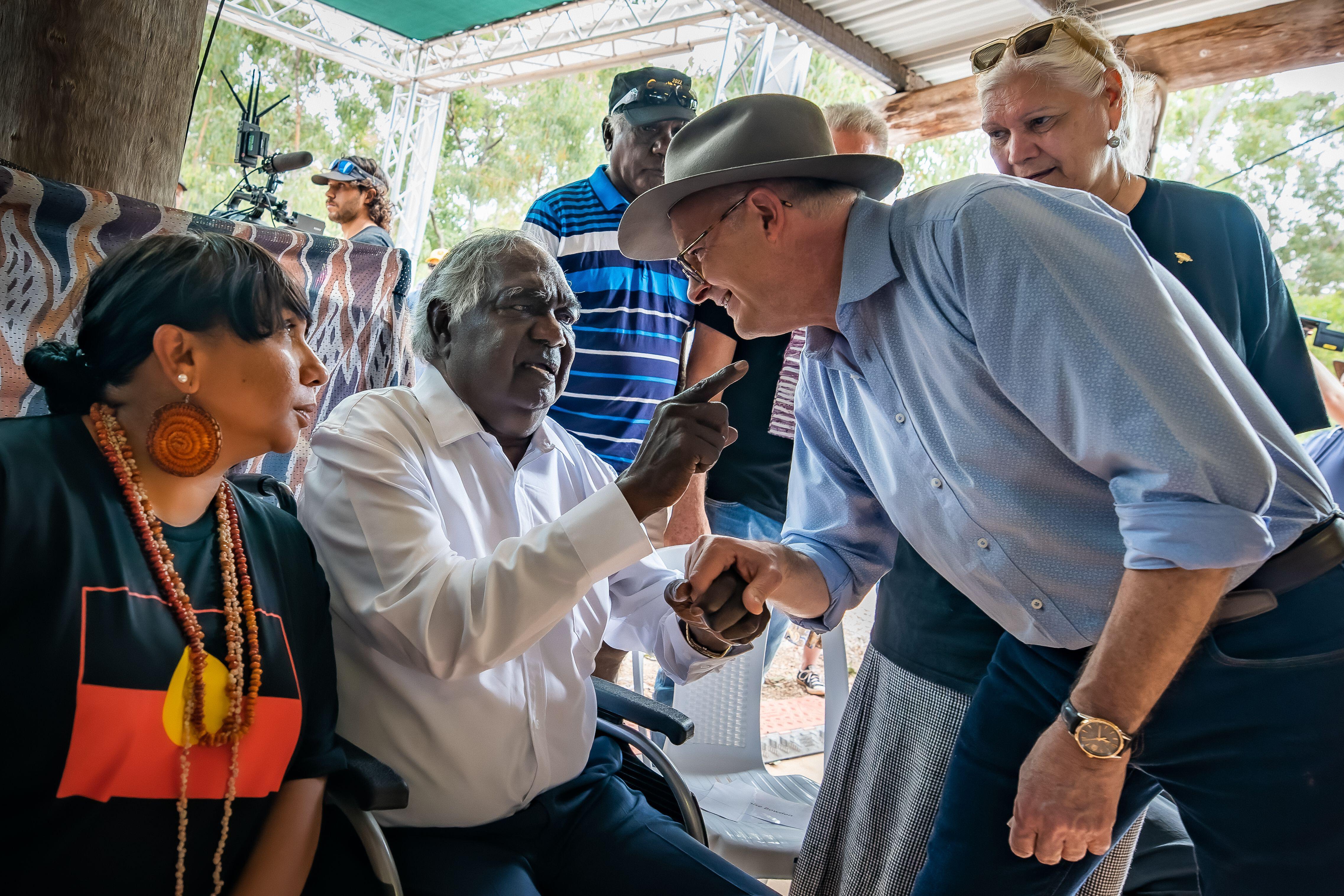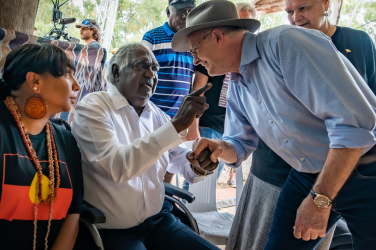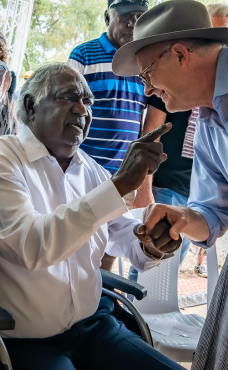
- Free Article: No
- Contents Category: Commentary
- Custom Article Title: Yunupingu's song
- Review Article: Yes
- Article Title: Yunupingu's song
- Article Subtitle: Constitutions as acts of vision, not of division
- Online Only: No
- Custom Highlight Text:
From the age of fifteen until his recent death at the age of seventy-four, the great Yolngu leader Yunupingu (1948–2023) was at the forefront of the struggle to change the Australian legal system in unprecedented ways. In 1963, with his father, Mungurrawuy, he drafted the Yirrkala Bark Petition, which presented to Parliament an eloquent claim for the rights of the Indigenous peoples of Arnhem Land before their country was, without their consent, turned into a bauxite mine. The Bark Petition was no ordinary document. On the one hand, it uses the antiquated language of a traditional ‘humble petition’ to Parliament, concluding in forms of speech that have hardly changed since the seventeenth century: ‘And your petitioners as in duty bound will ever pray.’
- Article Hero Image (920px wide):

- Article Hero Image Caption: Anthony Albanese and Yunupingu at the Garma Festival, 2022 ( Jiayuan Liang/Alamy)
- Featured Image (400px * 250px):

- Alt Tag (Featured Image): Desmond Manderson on the legacy of Yunupingu
The Select Committee appointed by Parliament to consider the case made a range of recommendations, including compensation, but the Menzies government paid no attention and granted Nabalco unimpeded rights to mine the land. However, Yunupingu was not about to stop. In the 1971 Gove Land Rights case, he shifted his ground from petition to a claim of right. The plaintiffs demanded nothing less than a complete repudiation of terra nullius, the legal doctrine in accordance with which the colonial legal system had dismissed the possibility of Indigenous property rights since colonial settlement, describing Australia as ‘empty land’, ‘desert and uncultivated’, peopled by tribes ‘so low in the scale of social organization that their usages and conceptions of rights and duties are not to be reconciled with the institutions or the legal ideas of civilized society’. Alas, Yunupingu’s second bold challenge was another failure. Justice Blackburn, in that case, categorically stated that ‘If ever a system could be called “a government of laws, and not of men”, it is that shown in the evidence before me.’ Nevertheless, he concluded that under Australian law his hands were tied. Terra nullius was false in fact, but true in law. But this cognitive dissonance unsettled our ‘views of the possible’ and paved the way for the High Court to finally overturn terra nullius in Mabo, twenty years on. No success without failure, or rather, without the kind of failure that haunts the conscience and forces us to start to reimagine the fundamental bases of the legal system.
Meanwhile, Yunupingu continued to probe the legal system’s every weakness. In 1978, as chairman of the Northern Lands Council, he helped negotiate and then administer the breakthrough Aboriginal Lands Rights (Northern Territory) Act 1976, which placed seventy per cent of the land mass of the Territory under Indigenous control. In 1988, he presented the prime minister, Bob Hawke, with the Barunga Statement. Not a ‘humble petition’, this time, or a claim based on existing law, but a set of far-reaching demands. In form, too, it once again combined Aboriginal art and identity with English-language demands in ways that subverted any neat legal hierarchies.
In 1991, Yothu Yindi, led by Yunupingu’s younger brother Mandawuy, entered the fray. Together with the rest of the band, the two brothers wrote, performed, and released ‘Treaty’, a piece of great musical power that became the anthem for a new generation of Aboriginal activists. The use of music was yet another way in which Yunupingu understood legal arguments as requiring not just new ideas but new aesthetics, new songs, new ways of touching the heart. Indeed, what was Yothu Yindi but a musical expression of Yunupingu’s uncompromising legal hybridity – an all-Indigenous band playing modern rock to an Aboriginal beat?
In 2015, Yunupingu was appointed to the Referendum Council. Two years later, it produced the Uluru Statement from the Heart. Here, once more, we see a highly creative approach to law-making. In its use of Indigenous art as a literal framing device, the Uluru Statement follows in the footsteps of the strategies of visual resistance pioneered by the Yirrkala Bark Petition and the Barunga Statement. In language, however, the Uluru Statement marks a departure from the formal, almost legalistic, English of earlier documents. Instead, the Uluru Statement is poetic, emotive, and intimate. It no longer attempts to mimic the voice of others.
Proportionally, we are the most incarcerated people on the planet. We are not an innately criminal people. Our children are aliened from their families at unprecedented rates. This cannot be because we have no love for them. And our youth languish in detention in obscene numbers. They should be our hope for the future.
Above and beyond its specific legal proposals, of which the Voice was the most prominent, the Statement from the Heart reached out across racial lines, seeking a new mode of engagement in which our legal relations could be reimagined, precisely ‘from the heart’ as well as with the head. What was being sought was a new affective constitution that would bind all Australians – Aboriginal and non-Aboriginal alike – to it.
We seek constitutional reforms to empower our people and take a rightful place in our own country. When we have power over our destiny our children will flourish. They will walk in two worlds and their culture will be a gift to their country.
In its consistently innovative and expansive understanding of legal change, its hybridity, and its aesthetics, its voice and its art, the Uluru Statement is neither trivial nor accidental. On the contrary, it reflects a profound vision for what it means to change a law or a constitution, and how that change comes about.
The Voice to Parliament, to be voted on by the Australian people later this year, stands at the end of this long process and, perhaps, as the ultimate challenge of Yunupingu’s creative vision. On one level, a constitution is simply a piece of legislation on steroids: a formal arrangement about the division of powers within a polity, entrenched to make it more or less difficult to modify. But on another level, a constitution is not an act of division but an act of vision: an articulation of values, histories, and aspirations. The idea that constitutions, as well as mere textual instruments, are repositories of stories and values, is most obviously true in places such as France or the United States, in which the constitutional order is embedded in a narrative of struggle and progress. It is equally true in places like Germany and South Africa, where the constitution represents a critical opportunity to reckon with and break from the past.
All over the world, stories of nation-building, constitution-making, and revolution are constantly reinscribed through school texts, annual holidays and rituals, and pilgrimages to sacred sites. The matter is less self-evident in Australia, where the Constitution seems to have so little to say about who we are and what we stand for. But neither it nor the judicial decisions that interpret it are devoid of a sense of Australia’s history or its trajectory, the past from which we come and the future to which we reach. It is this social and historical context that gives the Constitution its power to bind us and that makes it – and the referendum – something which actually matters.
What is at stake in these different ways of thinking about the Constitution is the relationship between law and time. According to a formal or technocratic view of the law, the legitimacy of the Constitution or, to put it more broadly, the ‘social contract’ between citizens and the State, its vision of the nation and the future, is a question that is decided in the founding moments of a legal system – let us say, in the case of Australia, from the Tenterfield Oration in 1889 until the passing of the Constitution Act in 1900; or, in the case of the United States, from the Declaration of Independence in 1776 to the ratification of the Constitution in 1787. Whole communities participated in shaping those debates and, in the process, gave shape to the polity to come. Once a new legal regime has been brought into existence, however, those contingent and participatory opportunities are thought to vanish like the morning mist once law’s new sun has risen.
But for many recent writers, this ‘constitutional moment’ cannot simply be relegated to a historical past. The upholding of a legal order is an ongoing task, not an historical fact. It is not enough to thank the founding fathers and move on. Neither is it only judges, politicians, or lawyers who are involved. Writes constitutional theorist Paul Blokker:
Constitutional experience consists of an on-going process of imagining and performing the constitutional – through fictions, metaphors, images, and conceptions – and in this depends on political imaginaries that shape and limit views of the possible, but that equally provide the basis for re-imagining the constitutional order.
In some tiny but important way, every day marks a new dawn.
In my admittedly limited understanding, it seems to me that Indigenous Australians have a profound and intrinsic awareness of this approach. Traditional Indigenous communities do not delegate law to lawyers or relegate it to the past. They consider it a collective, continuing, and everyday responsibility.
In ‘Everywhen’, an essay published last year in the Griffith Review, Mykaela Saunders observed that Western time is linear and singular. Aboriginal time is everywhere at once – not just time of a longer duration (65,000 years and counting), but the past and the present experienced simultaneously.
Time forever back and time forever onward lives in the land. All times are compressed and nested inside Country like sedimentary layers, and so it is inside people too. Time is inheritance: we are all embodiments of our families through bloodlines, and we personify our communities through culture. The way Aboriginal people make sense of ourselves is through our kinships, and these relationships deepen through time and across generations, accumulating stories in the process.
‘Aboriginal people talk of the past as though it is with us because it is,’ she writes. ‘For us, time is deepening and accumulating.’
One way I have come to understand this is through Aboriginal rock art. An old master like the Mona Lisa is put behind plate glass and a phalanx of security guards prevent us from getting close to it, let alone touching it. Its age separates us from it. It is not protected for us, but from us. Some Indigenous rock art is far, far older. But that does not mean that it has remained untouched ever since, a shrine to the past. On the contrary. In many cases, such art is regularly refreshed. The act of repainting the art is categorically not vandalism. It is rather a reaffirmation of its value and meaning to the community, a ritual process which brings the past to life in the present. By repainting the art, its custodians, although they are not its original ‘authors’, contribute to its meaning, ‘deepening’ and accumulating’ their relationship ‘through time and across generations’. Sometimes, the artwork may even be changed or reinterpreted in the process.
This is a very different way of understanding the relationship between past and present, between history and myth on the one hand, and the role of law in our everyday lives on the other. But it is striking how closely it parallels Blokker’s urge to reimagine the social contract and the constitution – not as an artefact locked in the vaults of linear time, but as an artwork whose place in the social order requires our active participation here and now. A constitution, to shift the metaphor to a different example reflecting the same underlying logic, is like a ‘songline’. It is not the record of a past event, an historical document or story that recalls what happened at a particular point in the distant past: it is a world which we are obligated to sing into existence now and every single day.
The Constitution, in short, is everywhen. The Voice to Parliament, like the Statement from the Heart before it, and the Gove Land Rights case before that, and the Yirrkala Bark Petition before that, and Indigenous visions of lawfulness stretching back many millennia in a wise and steady flow, is an expression of this ‘everywhen,’ rock art painted and repainted, songlines constantly being sung and re-sung in a collective act of the imagination.
The coming referendum is therefore not just about specific institutional arrangements. It pits against each other two opposed ideas about the relationship between the constitution and the people. The Constitution as a formal and technocratic document, held in time as in aspic; or the constitution as an ongoing discourse about how we need to learn to listen to one another and to talk to one another. The No vote responds to a certain way of thinking about law, time, and citizenship. The Yes vote derives from a very different way of thinking about law, time, and citizenship. It echoes ways of knowing with which Indigenous Australians are familiar and from which the rest of us still have much to learn.
Above all, this is what informed Yunupingu’s vision of the law throughout his life: a vision of the Constitution in this broader sense – as social and creative, embodied and embedded in cultural forms and vernaculars, constantly responsive to the changing dynamics of communities, seeking the words and the forms that best bring people and peoples together in better ways of living together. Like all of Yunupingu’s many and varied endeavours, the Voice to Parliament seeks to incorporate new voices in a new song, reflecting a distinctive vision of what constitutions are about, and why, and when. It is the ‘constitutional moment’ of our time.
In August 2022, at the Garma Festival – another important cultural event which Yunupingu and his brother established many years before – newly elected Labor Prime Minister Anthony Albanese met Yunupingu for the last time. Albanese announced the roadmap for this year’s referendum. Yunupingu reportedly asked the prime minister whether he meant what he said. He would not have been the first Indigenous leader to doubt the value of the white man’s word.
Albanese’s sincere commitment has something of the gravity of a deathbed promise about it. In 1963, parliament let Yunupingu down. In 1971 it was the judiciary; in 1988, a Labor prime minister; in 2017, a Liberal prime minister. In 2023, it is the people’s turn to have a say. Sadly, Yunupingu passed away in April. The Voice may be his lasting legacy; or the last in a long line of courageous disappointments.
This article is one of a series of ABR commentaries on cultural and political subjects being funded by the Copyright Agency’s Cultural Fund.



Comments powered by CComment